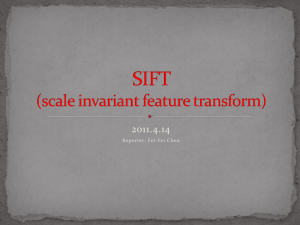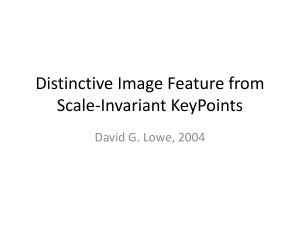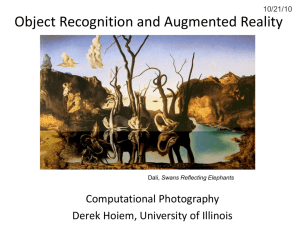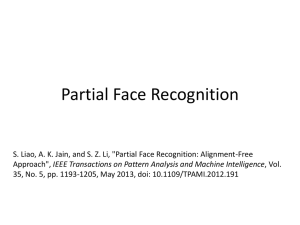IMAGE MATCHING WITH SIFT FEATURES – A PROBABILISTIC APPROACH
advertisement
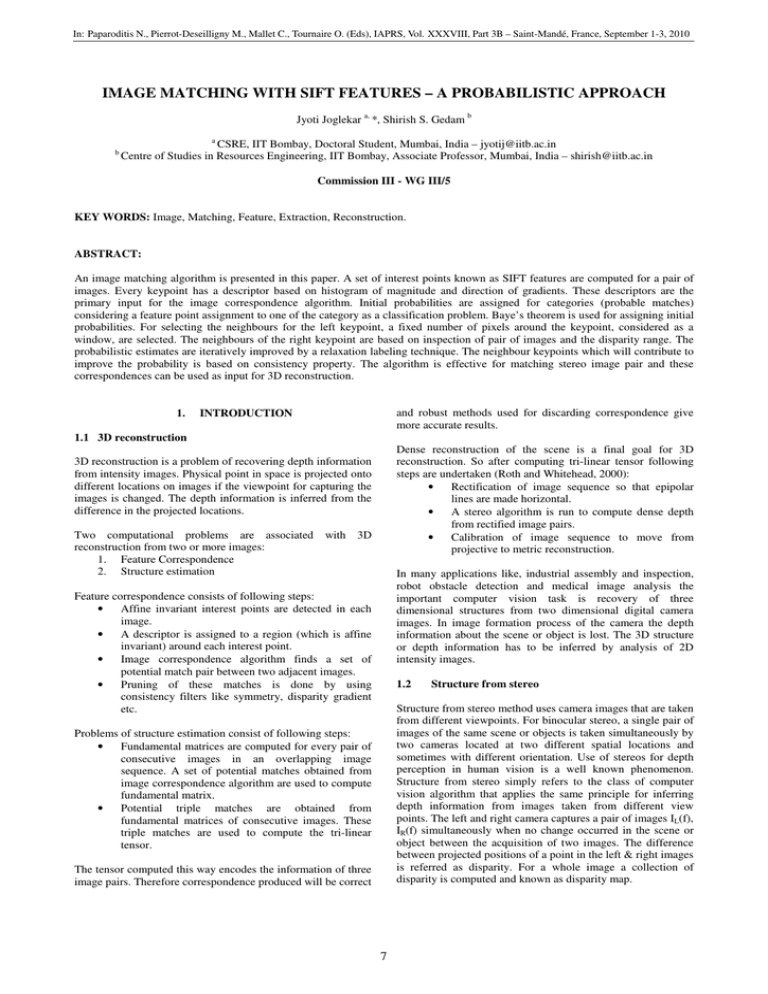
In: Paparoditis N., Pierrot-Deseilligny M., Mallet C., Tournaire O. (Eds), IAPRS, Vol. XXXVIII, Part 3B – Saint-Mandé, France, September 1-3, 2010 IMAGE MATCHING WITH SIFT FEATURES – A PROBABILISTIC APPROACH Jyoti Joglekar a, *, Shirish S. Gedam b b a CSRE, IIT Bombay, Doctoral Student, Mumbai, India – jyotij@iitb.ac.in Centre of Studies in Resources Engineering, IIT Bombay, Associate Professor, Mumbai, India – shirish@iitb.ac.in Commission III - WG III/5 KEY WORDS: Image, Matching, Feature, Extraction, Reconstruction. ABSTRACT: An image matching algorithm is presented in this paper. A set of interest points known as SIFT features are computed for a pair of images. Every keypoint has a descriptor based on histogram of magnitude and direction of gradients. These descriptors are the primary input for the image correspondence algorithm. Initial probabilities are assigned for categories (probable matches) considering a feature point assignment to one of the category as a classification problem. Baye’s theorem is used for assigning initial probabilities. For selecting the neighbours for the left keypoint, a fixed number of pixels around the keypoint, considered as a window, are selected. The neighbours of the right keypoint are based on inspection of pair of images and the disparity range. The probabilistic estimates are iteratively improved by a relaxation labeling technique. The neighbour keypoints which will contribute to improve the probability is based on consistency property. The algorithm is effective for matching stereo image pair and these correspondences can be used as input for 3D reconstruction. 1. and robust methods used for discarding correspondence give more accurate results. INTRODUCTION 1.1 3D reconstruction Dense reconstruction of the scene is a final goal for 3D reconstruction. So after computing tri-linear tensor following steps are undertaken (Roth and Whitehead, 2000): • Rectification of image sequence so that epipolar lines are made horizontal. • A stereo algorithm is run to compute dense depth from rectified image pairs. • Calibration of image sequence to move from projective to metric reconstruction. 3D reconstruction is a problem of recovering depth information from intensity images. Physical point in space is projected onto different locations on images if the viewpoint for capturing the images is changed. The depth information is inferred from the difference in the projected locations. Two computational problems are associated reconstruction from two or more images: 1. Feature Correspondence 2. Structure estimation with 3D In many applications like, industrial assembly and inspection, robot obstacle detection and medical image analysis the important computer vision task is recovery of three dimensional structures from two dimensional digital camera images. In image formation process of the camera the depth information about the scene or object is lost. The 3D structure or depth information has to be inferred by analysis of 2D intensity images. Feature correspondence consists of following steps: • Affine invariant interest points are detected in each image. • A descriptor is assigned to a region (which is affine invariant) around each interest point. • Image correspondence algorithm finds a set of potential match pair between two adjacent images. • Pruning of these matches is done by using consistency filters like symmetry, disparity gradient etc. 1.2 Structure from stereo Structure from stereo method uses camera images that are taken from different viewpoints. For binocular stereo, a single pair of images of the same scene or objects is taken simultaneously by two cameras located at two different spatial locations and sometimes with different orientation. Use of stereos for depth perception in human vision is a well known phenomenon. Structure from stereo simply refers to the class of computer vision algorithm that applies the same principle for inferring depth information from images taken from different view points. The left and right camera captures a pair of images IL(f), IR(f) simultaneously when no change occurred in the scene or object between the acquisition of two images. The difference between projected positions of a point in the left & right images is referred as disparity. For a whole image a collection of disparity is computed and known as disparity map. Problems of structure estimation consist of following steps: • Fundamental matrices are computed for every pair of consecutive images in an overlapping image sequence. A set of potential matches obtained from image correspondence algorithm are used to compute fundamental matrix. • Potential triple matches are obtained from fundamental matrices of consecutive images. These triple matches are used to compute the tri-linear tensor. The tensor computed this way encodes the information of three image pairs. Therefore correspondence produced will be correct 7 In: Paparoditis N., Pierrot-Deseilligny M., Mallet C., Tournaire O. (Eds), IAPRS, Vol. XXXVIII, Part 3B – Saint-Mandé, France, September 1-3, 2010 The feature correspondence problem can be best explained by an example. For instance a physical 3D point is projected on to Image X as point 1 and image Y as point 2. Then point 1 and point 2 are said to be correspondences. Hence the feature correspondence or feature matching problem is to find the point 2 on image Y given the location of point 1 on image X. Human vision is superb in solving this problem. Solving the problem by automation of process by computers is rather difficult. It searches the whole image Y for a point on image X. Some constraints can narrow down the search, but if sufficient constraints are not there the problem becomes difficult. presented in (Mikolajczyk and Schmid, 2004). It is known as gradient location and orientation histogram (GLOH). As number of directions chosen to represent the histogram in GLOH are more than SIFT the size of the descriptor is large in GLOH descriptor. The size is reduced using principle component analysis. Nowadays many detectors and descriptors algorithms are available for detecting corners edges and regions of interest. A vector is associated with it as a descriptor. The SIFT algorithm by Lowe is explained here which is used to provide primary input to the image matching algorithm explained in section 3. The detected region should have a shape which is a function of the image. To characterize the region invariant descriptor is computed for the extracted region. The second problem of structure estimation is relatively easy in comparison. After solving the correspondence problem a set of points are computed. If intrinsic and extrinsic parameters of the camera are known then exact reconstruction in absolute coordinates is possible. However the accuracy of the reconstruction depends on accuracy of these parameters. In addition, any errors in solving the correspondence problem between two images also affect the accuracy of the reconstruction. So, even if intrinsic and extrinsic parameters are known, the challenge remains for developing the matching algorithm that reduces the errors in the preprocessing steps to estimate the structure. For computing SIFT features and assigning descriptors to the features following procedure is used. : A pyramid of images is constructed with different scales of Gaussian function. From these Gaussian smoothed images Difference of Gaussian images are computed at different scales. Difference of Gaussian function detects the interest points invariant to scale and orientation in scale-space. The Difference of Gaussian function will have strong response along edges, though the location along the edge is poorly determined, as these locations are unstable to small amount of noise. A poorly defined peak in the Difference of Gaussian function will have a large principle curvature across the edge but small along perpendicular direction. Over all scales image locations are found to detect the extrema. Scales of keypoint is used to select the Gaussian smoothed image of closest scale, so that the computations are performed in scale invariant manner. 2. DETECTOR AND DESCRIPTOR 2.1 Point Detectors and Descriptors Parts of the image that have special properties and have some structural significance are usually referred as image features. The regions having visually identifiable textures are also referred as image features. Some of the examples are edges, corners, image gradients etc. Many computer vision applications have feature extraction process as an intermediate step for locating particular elements on an image. While extracting features some of the important factors to be considered are invariance, detectability, interpretability and accuracy. Many applications in the area of photogrammetry and computer vision use feature extraction as primary input for further processing and analysis. Features are used for image registration, 3D reconstruction, motion tracking etc. Invariance property of feature extractor is very important as under different transformations (geometric and radiometric) the same features should be detectable in pair of stereo images, so that they will be useful for matching process. (Remondino, 2006) For keypoint localization a model based on Taylor series is fit to every keypoint location and scale. Here stability (i.e. invariance to transformation) is the measure of selecting the interest points. For each image sample for the scale L, gradient magnitude and orientation is computed using pixel difference. Considering image gradient at every keypoint one or more orientations are assigned to the keypoints. These orientations and the respective magnitude at selected scales are used to construct a 3D histogram for the region around the keypoint. The descriptor computed using these gradient magnitude and orientation at each image sample point is weighted by Gaussian window. A Gaussian weighting function with σ equal to one half of the width of the descriptor window is used to assign a weight to the magnitude of each sample point. This Scale invariant feature descriptor for every keypoint is of dimension 128 (Lowe, 2004). 2D locations in the images are located by the detectors. After analyzing the region around the location a descriptor is assigned to the location (interest point) which characterizes the interest point under consideration with respect to its neighboring points, using information about neighboring points like intensity variation, change in gradient, histogram considering gradient direction and magnitude. 2.2 3. MATCHING MODEL When the set of keypoints are found next step is to construct a set of possible matches. Ideally we want to match each keypoint in the left image, which is considered as reference image, with a keypoint in the right image. But in reality in a stereo image pair we can find valid matches for some of the keypoints in the left image. SIFT Algorithm In SIFT descriptor (Lowe, 2004) DoG detector is used to detect interest points and the extracted regions are described by a vector of dimension 128. The descriptor is normalized by dividing the descriptor vector by square root of sum of the squared components, so that the descriptor becomes illumination invariant. A 3D histogram of gradient location and orientation is used as a descriptor. With various measures it is demonstrated that SIFT descriptors outperform (Mikolajczyk and Schmid, 2003). Extended version of SIFT descriptor was A primary input to the matching algorithm is a set of keypoint with their descriptors computed using SIFT algorithm, explained in the section 2.2. An image correspondence algorithm is proposed and presented in detail steps as below. 8 In: Paparoditis N., Pierrot-Deseilligny M., Mallet C., Tournaire O. (Eds), IAPRS, Vol. XXXVIII, Part 3B – Saint-Mandé, France, September 1-3, 2010 1. 2. 3. 4. 5. 6. 7. 8. 9. 10. 11. 16. Key-points selection in both the images (left and right) with SIFT. For every keypoint from both the images a descriptor is computed as below i) Around every keypoint a pixel area of size 16 x 16 is considered. ii) For each sample of size 4 x 4 gradient magnitude & orientation are assigned. iii) A histogram of Gradient orientation showing 8 bins gives a descriptor for every 4 x 4 sample size. iv) For a 16 x 16 sample size around the keypoint a descriptor vector of dimension 4 x 4 x 8 is obtained. An approximate maximum disparity range is found by visual inspection of few matching keypoints in the stereo image pair. The disparity is present in the left and right image as the stereo images are captured from different viewpoints and orientations. An area is selected around every right keypoint node, considering possible maximum disparity range. All the keypoints are found in the area selected in step 4, around a right keypoint node in the right image. The procedure of step 4 and 5 is iteratively performed for all the right keypoints and the area around each right keypoint is selected considering the approximate maximum disparity range. The procedure in steps 4 and 5 is repeated for all left keypoints from left image iteratively. But here area around the left keypoint is a fixed sample area of size 16 x 16 As shown in figure 1, the left keypoint node bi is paired with every right keypoint node ci and the pair is called as category pair For every category pair, Euclidian distance between the descriptors of the keypoints is calculated. Weight is assigned to every right keypoint ci , in the selected area. The weight is inversely proportional to the Euclidian distance between the corresponding descriptors. For every category ci the weight is calculated as 17. p io (c ) = 1 − max ( wi (c)) c≠c 18. 12. 13. 14. 15. 1 , c≠c k × ε i (c ) + 1 (2) By applying Baye’s rule p io (c ) = p i (c i) × (1 − p io (c )) , c ≠ c p i (c i ) : (3) conditional probability that bi has category c as matching, given that bi is matchable (1 − p io (c ) ) : prior probability that bi matchable 19. is Estimating p i (c i ) as below p i (c i ) = wi (c) L (4) ∑ wi (c ′) c '=1 c '≠ c 20. 21. 22. wi (c ) = The weights can not be used as probability estimates as wi (c ) is undefined and weights will not sum up to 1. Considering the keypoint matching as a classification problem, bi is classified to one of the category ci. Initial probability for undefined category is given as (1) 23. k is a positive constant A disparity category which associates highly similar pairs of region will have large weight value. wi (c) will be in the interval [0, 1] and weight is inversely proportional to Euclidian distance. For every category set c, c is undefined disparity category. Consider weight wi (c ) for c which is undefined i.e. keypoint bi(x,y) from left image does not correspond to any keypoint in the right selection area of right image. Initial probabilities are assigned to every category ci from right selection by equation (2), (3) and (4). Initial probabilities which depend only on the similarity of neighborhood of candidate matching points can be improved using consistency property. The probability updating rule should have following property : The new probability pik +1 (c) should tend to increase when descriptors with highly probable category consistent with c are found nearby the keypoint region. Categories are considered consistent if they represent nearly the same disparity i.e. d (ci ) − d (cm ) < Threshold: The threshold has to be decided empirically by inspection of stereo image pair. 24. 9 For computing new probability pik +1 (c) for all ci in category set c, likelihood estimation is done. The degree to which the cj of c strengthen pi(c) should be related to estimated likelihood. In: Paparoditis N., Pierrot-Deseilligny M., Mallet C., Tournaire O. (Eds), IAPRS, Vol. XXXVIII, Part 3B – Saint-Mandé, France, September 1-3, 2010 qijk (c) = Figure 2 is a test stereo image pair. Figure 3 shows the performance of the algorithm using Euclidian distance and Best Bin First approach to compare closest neighbor to that of second closest neighbor. All matches where distance ratio is greater than 0.7 are rejected. The matches found with this method are 244 for the given test stereo image pair in figure 2. Figure 4 shows the performance of the matching algorithm with probabilistic approach. For a specific left keypoint, the set of right keypoints probabilities are evolved, through the iterations, using consistency property and relaxation labeling technique. The neighbouring keypoints contribute in deciding the final selection of keypoint from the right image. Over six iterations the probabilities of right keypoints are evolved. The result of 2nd, 4th and 6th iterations is shown in figure 4. L ∑ p ( cm ) (5) m =1, m ≠ j where d (ci ) − d (cm ) < Th qijk (c) : Estimated likelihood considering the neighborhood of cj L : Number of neighbours in the category set. 25. Rule for updating category probability is p ijk +1 (c) = p ik (c)q ijk (c) L ∑ c′=1 The candidate matching points selected with every iteration are superimposed on the images. The equation (1) in the proposed algorithm computes the weights using the Euclidian distance between the left and right keypoint descriptor. The descriptors are computed by the binary code for SIFT provided by Lowe and freely available on site http://www.cs.ubc.ca/~lowe/keypoints/ (6) p ik (c ' )q ijk (c' ) where denominator acts as normalizing factor If the correct disparity range is known then the time complexity of the algorithm improves as the selection of the number of keypoints for left and right image will be minimum with the exact disparity range. Although if the disparity range is not known accurately, the algorithm works efficiently giving the correct and more number of valid matches as compared to the Euclidian distance (BBF algorithm) method. N pik +1 (c ) = ∑ a j pijk +1 (c) (7) j =1 26. 27. Here category probability is updated iteratively. The values in the kth iteration are used to calculate values in k+1th iteration. aj are the weights associated with contribution of different neighbors of bi. N is the number of neighborhood points of bi. As shown in figure 1 there are four neighborhood points in the left selected area. Hence N = 4. aj can be constant for all the neighbors or vary. For updating probabilities of categories in the right image, equations (5), (6), (7) are used iteratively. After few iterations most possible matching categories will have very low probability. The category with highest probability is the most perfect match. Number of correct matches is counted considering limiting candidate probability greater than 0.7. Comparison of number of matched points with the method using only Euclidian distance criteria (BBF algorithm) and the method presented in the algorithm of section 3 is shown in Table 1. The presented matching algorithm is robust to 2D rotation in image plane, as rotation and scale invariant SIFT algorithm is used for selecting the keypoints. In case of rotation, different neighbouring keypoints are selected as the right image plane is rotated. But number of keypoints selected in the right selection area will not vary much as the disparity range does not change. In case of scaling of the right image, if right image is enlarged the disparity range increases. Hence the sample size around the keypoint under consideration increases. But it hardly affects the computing speed, as number of neighbouring keypoints found in the selected area are in same numbers. 4. RESULTS AND DISCUSSION Interesting property of this matching algorithm is that it works for any range of disparity between a pair of stereo images and does not require information regarding camera orientation. Disparity in the pair of images of the same scene or object is due to translation or rotation of the sensor. A photogrammetric model could translate this disparity information in to quantitative measurement of depth, so that 3D reconstruction of the scene is possible. In the presented algorithm, the probability of the valid match is improved by considering relative positions of the neighbors using the distance between the neighbors. As the relative distance between the neighbors is used to improve the probability of the correct match, the accuracy to choose a correct match among the neighbors also improves. Figure 1: bi is the keypoint in the selected area from the left image and cj is the keypoint in the selected area from the right image. bi and cj together makes a category pair 10 In: Paparoditis N., Pierrot-Deseilligny M., Mallet C., Tournaire O. (Eds), IAPRS, Vol. XXXVIII, Part 3B – Saint-Mandé, France, September 1-3, 2010 Image Selected keypoints Method Left Image Test Image 1 (shown in Figure 2) Test image 2 Matches found Right Image Algorithm considering Euclidian distance only 378 376 244 Algorithm with Probabilistic approach 378 376 286 Algorithm considering Euclidian distance only 1855 2139 843 Algorithm with Probabilistic approach 1855 2139 1020 Table 1. Comparison of matched points Figure 2: A pair of stereo images with keypoints superimposed on it Figure 3: Result of matching algorithm with Euclidian distance (BBF algorithm). The joined lines show few matching point pairs of left and right images. There are total 244 matches. ( (a) (b) (c) Figure 4: Iteration (a), (b), (c) shows matched points in the right image after 2nd, 4th and 6th iterations. 11 In: Paparoditis N., Pierrot-Deseilligny M., Mallet C., Tournaire O. (Eds), IAPRS, Vol. XXXVIII, Part 3B – Saint-Mandé, France, September 1-3, 2010 5. CONCLUSION 7. ACKNOWLEDGEMENT Disparity map between images is very useful input for 3D reconstruction. Conventionally cross-correlation approach is used to find image correspondences in a stereo image pair, but it is prone to errors caused by distortion in the imaging process. Sincere thanks to Dr. B. K. Mohan, IIT Bombay, India, for the guidance in the area, Relaxation labeling technique. The probabilistic approach explained in the presented algorithm is using consistency property to improve the candidate probabilities using relaxation labeling technique. Instead of keypoint by keypoint matching, the approach of finding neighbouring keypoints and selecting the match for the keypoint under consideration in the selected area of left image, using neighbouring keypoints contribution from selected area of right image, improves accuracy of the valid match. Expensive two dimensional search over the entire image is reduced by applying interest point operator to both the images, and it also greatly improves in search space. The algorithm converges quickly with few iterations and can be applied to images having wide disparity range. It is robust over a large range of disparity. The method is robust to 2D rotation in image plane and scaling. 6. REFERENCES B. Krishna Mohan, “Neural Networks And Fuzzy Logic In Remote Sensing, in Landslide Disaster Assessment and Monitoring”, R. Nagarajan (ed.) Anmol Publishers Pvt. Ltd., New Delhi, 2004. C. P. Jerian and R. Jain, “Structure from motion — a critical analysis of methods,” IEEE Trans. Systems, Man, and Cybernetics, 21(3):572–588, 1991. Lowe, D., “Distinctive image features from scale-invariant keypoints,” International Journal of Computer Vision, Vol. 60(2), pp. 91-110, 2004. Lucas B. D. and Kanade T., “An iterative image registration technique with an application to stereo vision,” Proc. 7th Int. Joint Conf. on Artificial Intelligence, 674–679, 1981. Marr D and Poggio T, “Cooperative computation of stereo disparity,” Science, vol. 194, pp. 283-287, Oct. 15, 1976. Mikolajczyk, K. and Schmid, C., “A performance evaluation of local descriptors,” Proc. of CVPR, 2003. Mikolajczyk, K. and Schmid, C., “Scale and Affine Invariant Interest Point Detectors,” Int. Journal Computer Vision, Vol. 60(1), pp. 63-86, 2004. Remondino F., “Detectors and descriptors for photogrammetric applications”, Photogrammetric and computer vision ISPRS symposium, Bonn, Germany, 2006. Rosenfeld A, Hummel R. A., and Zucker S. W., “Scene labeling by relaxation operations,” IEEE Trans. Syst., Man, Cybern., vol. SMC-6, June 1976. Roth G., Whitehead A., “Using Projective vision to find Camera Positions in an Image Sequence,” Proc. of Vision Interface, pp.225-232, 2000. 12
